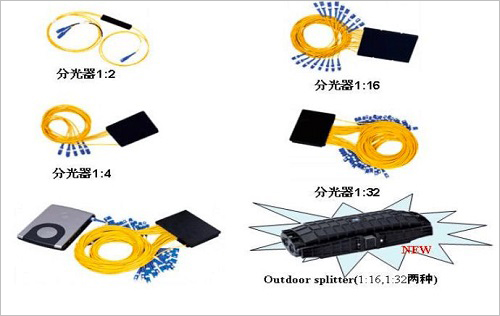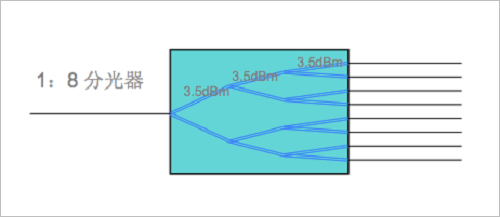The optical splitter is a component of the PON network. It is a passive device that connects the OLT and the ONU. Its function is to distribute downlink data and concentrate uplink data. The optical splitter has an upstream optical interface and a plurality of downstream optical interfaces. The optical signal from the upstream optical interface is allocated to all downlink optical interfaces for transmission, and the optical signal from the downstream optical interface is transmitted to the upstream optical interface of only Yi. When the optical signal is transferred from the upstream optical interface to the downstream optical interface, the optical signal strength/optical power will decrease, and the same is true when the optical interface is switched from the downstream optical interface to the upstream optical interface. The optical signal strengths of the downlink optical interfaces may be the same or different.

Working principle: When a single-mode fiber conducts an optical signal, the energy of the light is not completely concentrated in the core, and a small amount is propagated through the cladding near the core, that is, in the two fibers. When the core is close enough, the mode field of the light transmitted in one fiber can enter another fiber, and the optical signal is redistributed in the two fibers.
Beam splitter calculation

• Optical power loss is related to the number of light branches (~3.5dB loss per 1â„2 split)
• The amount of loss of optical power determines the distance that can be transmitted
• Bandwidth vs. Cost: The average available bandwidth per household depends on the size of the optical split ratio. The higher the split ratio, the lower the cost per OLT.


Splitter type
The optical splitters are mainly divided into two categories according to the manufacturing process: FBT type (fused cone type beam splitter) and PLC type (planar optical waveguide power splitter).
The fusion taper technology bundles two or more optical fibers together and then melts and stretches them on a taper. During the stretching process, the optical fiber coupling split ratio is monitored. After the splitting ratio reaches the requirement, the melt stretching is completed, one end of which remains. One fiber (the rest is clipped) is used as the input and the other end is used as the multi-output.
The planar optical waveguide technology is based on optical integration technology. The optical waveguide branching device is fabricated by a semiconductor process, and the function of the shunt is completed on the chip.
According to the scope of application, it can be divided into: box type beam splitter, tray type beam splitter, rack type beam splitter, wall-mounted beam splitter, and the like. The box type beam splitter is mainly used in the ODF frame of the machine room, and the cable is transferred in the box. The tray type splitter can only be installed in the ODF rack or the cable transfer box of the equipment room. Rack splitters can only be installed in a standard rack. Wall-mounted beamsplitters are mounted on the wall and can be installed in corridors and corridors.
Fruit Vegetable Blanching Machine
Fruit Vegetable Blanching Machine:
This machine is made of full 304 stainless steel. It is avaliable for different kinds of fruits vegetables, bottles etc.
This vegetable blanching machine is used to protect color and make good taste for chips. With the hot water to cook the chips for the good taste. It is mainly equipped with our factory production of vegetables processing line, Fried potato chips (French fries) assembly line, drying dehydration lines.
Equipment advantages:
1. The blanching machine is mainly used for the processing of vegetables and petal plants. The purpose of the blanching machine is to preserve the color. The water inside the blanching machine is hot water, and the heating method is electric heating or steam heating. The blanching machine adopts mechanized operation completely in the process of use, without manual operation. The material is fed into the blanching machine through a mesh belt/conveyor belt or manually. The equipment inside the blanching machine is controlled by frequency conversion, and the blanching time can be set according to different product processes.
2. The machine adopts SUS304 stainless steel plate mesh belt for transmission. The mesh belt has the characteristics of high strength, small flexibility, non-deformation, easy maintenance, etc., the whole machine is balanced in operation and low in noise, which greatly improves work efficiency. When the material is discharged, it is lifted with a mesh belt to directly transport the material out of the equipment. ...
3. The heating source of this machine is steam heating, with automatic control of steam inlet device and surface insulation. Minimize energy waste. ...
4. The transmission system of the machine adopts a speed-adjustable decelerating motor to make the conveying speed of the conveyor belt adjustable, and the blanching time can be adjusted between 3-15min.
Fruit Vegetable Blanching Machine,Vegetable Blanching Machine,Fruit Blanching Machine,Blanching Machine
Henan Gems Machinery Co.,Ltd , https://www.gemsmachines.com



